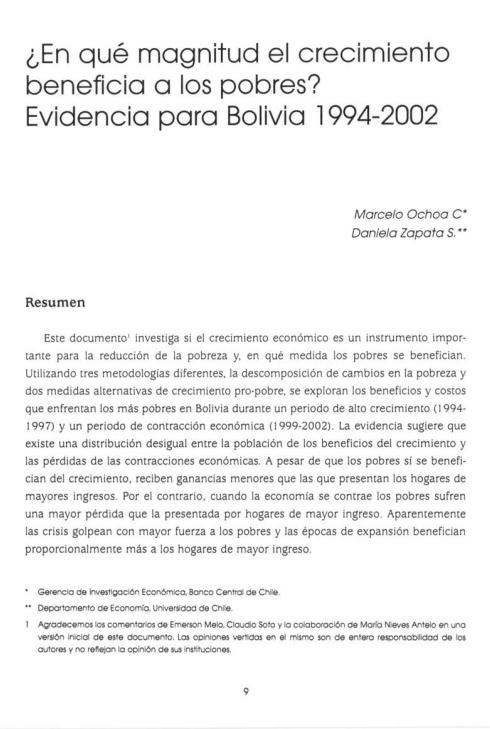To what extent does growth benefit the poor? Evidence for Bolivia 1994-2002
DOI:
https://doi.org/10.35319/lajed.20079363Keywords:
magnitude, increase, povertyAbstract
This paper explores the importance of growth as an instrument to reduce poverty and the extent to which the poor benefit from growth. Using three alternative methodologies, a poverty decomposition and two measures of pro-poor growth, we examine the benefits and costs the poor in Bolivia have to tackle during a high growth period (1994-1997) and a period of economic contraction (1999-2002). Our findings suggest that the benefits from growth and costs of economic crisis are distributed unequally. Even though, the poor do benefit in high growth environments, they share much smaller gains than wealthy households. In contrast, when the economy contracts the poor acquire most of the looses. Evidently, economic crises disadvantage the poor, and economic expansions favor the wealthy.Downloads
References
Ahluwalia, Moruek. 1976. “Inequality, Poverty and Development”. Journal of Development Economics. 3: 307-342.
Ali, A. y I. Elbadewi. 1999. “Inequality and the Dynamics of Poverty and Growth” CID Working Paper N°. 32, Center for International Development at Harvard University.
Alesina, Alberto y Dani Rodrik. 1994. “Distributive Politics and Economic Growth”. The Quarterly Journal of Economics. MIT Press, vol. 109(2): 465-90, May.
Banco Mundial. 2002. Bolivia Poverty Diagnosis 2000. Report N°. 20530-BO Washington DC.
Bruno, M., M. Ravallion y L. Squire. 1998. “Equity and Growth in Developing Countries: Old and New Perspectives on the Policy Issues”. In: Vito Tanzi y Ke-Young Chu (eds.). Income Distribution and High-Quality Growth. Cambridge y London: MIT Press.
Contreras, D. y M. Galván. 2003. “Reformas estructurales, crecimiento económico, pobreza y desigualdad: Bolivia 1989-1999”, mimeo Universidad de Chile.
Chen, S., D. Gaurav y M. Ravallion. 1993. “Is Poverty Increasing in the Developing World?”. World Bank Working Paper.
Chenery, H. y M. Ahluwalia, C.L.G. Bell, J. Duly y R. Jolly. 1974. Redistribution with Growth. New York: Oxford University Press.
Datt, G. 1998. “Computational Tools for Poverty Measurment and Analysis”, FCND discussion paper N°. 50, The World Bank Food Consumption and Nutrition Division.
Datt, G. y M, Ravallion. 1992. “Growth and Redistribution Components of Changes in Poverty Measures: A decomposition with Applications to Brazil and India in the 1980s”. Journal of Development Economics 38(2): 275-295.
Deaton, A. 2003. “Measuring Poverty in a Growing World (or Measuring Growth in a Poor World)”, document presented at the Review of Economics and Statistics Lecture en la Universidad de Harvard.
____. 2000. Analysis of Household Surveys: A Microeconometric Approach to Development Policy The Johns Hopkins University Press. Published for the World Bank.
Deininger, K y L, Squire. 1997. “A New Data Set Measuring Income Inequality”. The World Bank Economic Review, 10:3.
Dollar, D. and A, Kray. 2000. “Growth is Good for the Poor”. World Bank Working Paper.
Fields, G. 1991. “Growth and Income Distribution”. En: George Psacharpoulos. (ed.). Essays on Poverty. Equity and Growth Oxford and New York: Perganom.
Forsyth, J. 2000 “Letter to the Editor”. The Economist, June, 2000.
Hernany, W. 1999. “La pobreza en el área urbana de Bolivia: evolución, perfiles, deter- minantes y políticas de alivio”. Tesis para la Obtención del Grado Académico de Licenciatura en Economía. Universidad Católica Boliviana. La Paz, Bolivia.
Kakwani, N., S. Khandker y H. H. Son. 2003. “Poverty Equivalent Growth Rate: With Applications to Korea and Thailand”, mimeo The World Bank.
Kakwani, N. 1980. Income Inequality and Poverty. Methods of Estimation and Policy Applications. New York Oxford University Dress.
Klasen, S. 2001. In search of the Holly Grail: How to Achieve Pro-Poor Growth?. Mimeo, University of Munich.
Kuznets, S. 1955. “Economic Growth and Income Inequality” American Economic Review. Vol. 45. N°1, marzo, 1955; pp. 1-28.
Lewis. A. 1983. “Development and Distribution”. En: Mark Gersovitz (ed. ) Selected Economic Writings of W. Arthur Lewis. New York University Press.
Lora, E. 2001. ¿Por qué Bolivia no crece más? Inter-American Development Bank, abril 2002
Pereira, R. y W, Jiménez. 1998. “Políticas macroeconómicas, pobreza y equidad en Bolivia". En: E. Ganuza, L. Taylor y S. Morley (eds.) Política macroeconómica y pobreza en America Latina y el Caribe. Madrid: PNUD-CEPAL-BID.
Ravallion, M. y S, Chen. 2003. “Measuring Pro-Poor Growth". Economic Letters. 78: 93-99
Ravallion, M. y M, Huppi. 1991. "Measuring Changes in Poverty: A methodological Case Study of Indonesia During an Adjustment Period". World Bank Economic Review 5(1): 57-82.
Roemer, M. y M, Gugerty. 1997. "Does Economic Growth Reduce Poverty?" CAER II Discussion Paper N°. 4 y 5. Harvard Institute for International Development.
Rodrik, D. 1998. “Where Did All the Growth Go? External Shocks, Social Conflict and Growth Collapses". Harvard University, John F. Kennedy School of Government. Mimeo.
Son, H. 2003 "A Note on Measuring Pro-Poor Growth". The World Bank. Mimeo.
Timmer, C. P. 1997. "Farmers and Markets: The Political Economy of New Paradigms." American Journal of Agricultural Economics .79: 621-627.
Urquiola, M. 1994. "Participando en el crecimiento: expansión económica, distribución del ingreso y pobreza en el área urbana de Bolivia: 1989-1992 y proyeccio- nes". Cuadernos de investigación N°.2 UDAPSO.
Villasenor, Jose y Barry C. Arnold. 1989. "Elliptical Lorenz Curves "Journal of Econometrics. 40: 327-338.
Villasenor, Jose y Barry C. Arnold. 1984. “Some examples of fitted general cuadratic Lorenz curves". Technical report, N°.130. University of California.
Vos, R., H. Lee yJ.A. Mejia. 1998. “Structural Adjustment and Poverty". En: P. Van Dick (ed.) The Bolivian Experiment: Structural Adjustment and Poverty Alleviation CEDLA. Latin America Studies N°. 84. Amsterdam.






